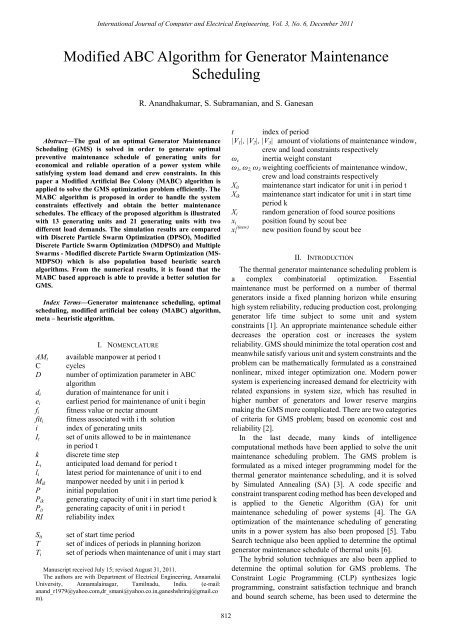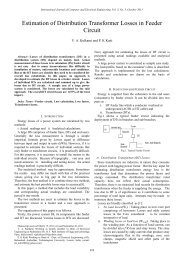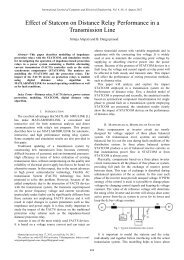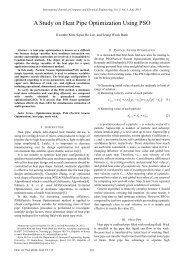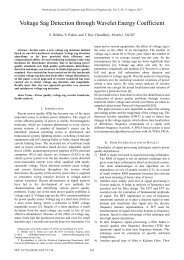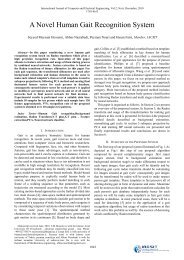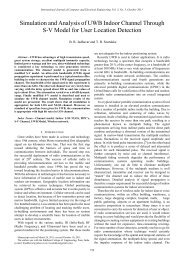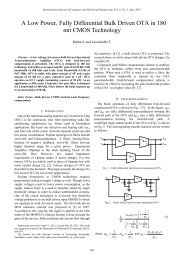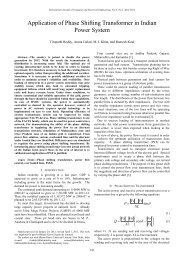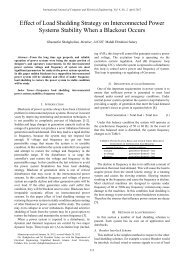Modified ABC Algorithm for Generator Maintenance Scheduling - ijcee
Modified ABC Algorithm for Generator Maintenance Scheduling - ijcee
Modified ABC Algorithm for Generator Maintenance Scheduling - ijcee
You also want an ePaper? Increase the reach of your titles
YUMPU automatically turns print PDFs into web optimized ePapers that Google loves.
International Journal of Computer and Electrical Engineering, Vol. 3, No. 6, December 2011<br />
<strong>Modified</strong> <strong>ABC</strong> <strong>Algorithm</strong> <strong>for</strong> <strong>Generator</strong> <strong>Maintenance</strong><br />
<strong>Scheduling</strong><br />
R. Anandhakumar, S. Subramanian, and S. Ganesan<br />
Abstract—The goal of an optimal <strong>Generator</strong> <strong>Maintenance</strong><br />
<strong>Scheduling</strong> (GMS) is solved in order to generate optimal<br />
preventive maintenance schedule of generating units <strong>for</strong><br />
economical and reliable operation of a power system while<br />
satisfying system load demand and crew constraints. In this<br />
paper a <strong>Modified</strong> Artificial Bee Colony (M<strong>ABC</strong>) algorithm is<br />
applied to solve the GMS optimization problem efficiently. The<br />
M<strong>ABC</strong> algorithm is proposed in order to handle the system<br />
constraints effectively and obtain the better maintenance<br />
schedules. The efficacy of the proposed algorithm is illustrated<br />
with 13 generating units and 21 generating units with two<br />
different load demands. The simulation results are compared<br />
with Discrete Particle Swarm Optimization (DPSO), <strong>Modified</strong><br />
Discrete Particle Swarm Optimization (MDPSO) and Multiple<br />
Swarms - <strong>Modified</strong> discrete Particle Swarm Optimization (MS-<br />
MDPSO) which is also population based heuristic search<br />
algorithms. From the numerical results, it is found that the<br />
M<strong>ABC</strong> based approach is able to provide a better solution <strong>for</strong><br />
GMS.<br />
Index Terms—<strong>Generator</strong> maintenance scheduling, optimal<br />
scheduling, modified artificial bee colony (M<strong>ABC</strong>) algorithm,<br />
meta – heuristic algorithm.<br />
AM t<br />
C<br />
D<br />
d i<br />
e i<br />
f i<br />
fit i<br />
i<br />
I t<br />
k<br />
L t<br />
l i<br />
M ik<br />
P<br />
P ik<br />
P it<br />
RI<br />
S it<br />
T<br />
T i<br />
I. NOMENCLATURE<br />
available manpower at period t<br />
cycles<br />
number of optimization parameter in <strong>ABC</strong><br />
algorithm<br />
duration of maintenance <strong>for</strong> unit i<br />
earliest period <strong>for</strong> maintenance of unit i begin<br />
fitness value or nectar amount<br />
fitness associated with i th solution<br />
index of generating units<br />
set of units allowed to be in maintenance<br />
in period t<br />
discrete time step<br />
anticipated load demand <strong>for</strong> period t<br />
latest period <strong>for</strong> maintenance of unit i to end<br />
manpower needed by unit i in period k<br />
initial population<br />
generating capacity of unit i in start time period k<br />
generating capacity of unit i in period t<br />
reliability index<br />
set of start time period<br />
set of indices of periods in planning horizon<br />
set of periods when maintenance of unit i may start<br />
Manuscript received July 15; revised August 31, 2011.<br />
The authors are with Department of Electrical Engineering, Annamalai<br />
University, Annamalainagar, Tamilnadu, India. (e-mail:<br />
anand_r1979@yahoo.com,dr_smani@yahoo.co.in,ganeshshriraj@gmail.co<br />
m).<br />
t index of period<br />
|V 1 |, |V 2 |, |V 3 | amount of violations of maintenance window,<br />
crew and load constraints respectively<br />
ω c inertia weight constant<br />
ω 1 , ω 2, ω 3 weighting coefficients of maintenance window,<br />
crew and load constraints respectively<br />
X it maintenance start indicator <strong>for</strong> unit i in period t<br />
X ik maintenance start indicator <strong>for</strong> unit i in start time<br />
period k<br />
X i random generation of food source positions<br />
x i position found by scout bee<br />
new position found by scout bee<br />
x i<br />
j(new)<br />
II. INTRODUCTION<br />
The thermal generator maintenance scheduling problem is<br />
a complex combinatorial optimization. Essential<br />
maintenance must be per<strong>for</strong>med on a number of thermal<br />
generators inside a fixed planning horizon while ensuring<br />
high system reliability, reducing production cost, prolonging<br />
generator life time subject to some unit and system<br />
constraints [1]. An appropriate maintenance schedule either<br />
decreases the operation cost or increases the system<br />
reliability. GMS should minimize the total operation cost and<br />
meanwhile satisfy various unit and system constraints and the<br />
problem can be mathematically <strong>for</strong>mulated as a constrained<br />
nonlinear, mixed integer optimization one. Modern power<br />
system is experiencing increased demand <strong>for</strong> electricity with<br />
related expansions in system size, which has resulted in<br />
higher number of generators and lower reserve margins<br />
making the GMS more complicated. There are two categories<br />
of criteria <strong>for</strong> GMS problem; based on economic cost and<br />
reliability [2].<br />
In the last decade, many kinds of intelligence<br />
computational methods have been applied to solve the unit<br />
maintenance scheduling problem. The GMS problem is<br />
<strong>for</strong>mulated as a mixed integer programming model <strong>for</strong> the<br />
thermal generator maintenance scheduling, and it is solved<br />
by Simulated Annealing (SA) [3]. A code specific and<br />
constraint transparent coding method has been developed and<br />
is applied to the Genetic <strong>Algorithm</strong> (GA) <strong>for</strong> unit<br />
maintenance scheduling of power systems [4]. The GA<br />
optimization of the maintenance scheduling of generating<br />
units in a power system has also been proposed [5]. Tabu<br />
Search technique also been applied to determine the optimal<br />
generator maintenance schedule of thermal units [6].<br />
The hybrid solution techniques are also been applied to<br />
determine the optimal solution <strong>for</strong> GMS problems. The<br />
Constraint Logic Programming (CLP) synthesizes logic<br />
programming, constraint satisfaction technique and branch<br />
and bound search scheme, has been used to determine the<br />
812
International Journal of Computer and Electrical Engineering, Vol. 3, No. 6, December 2011<br />
optimal solution [7]. Logic programming and constraint<br />
satisfaction technique are used to prune away the infeasible<br />
solutions from the search domain. The optimal solutions are<br />
obtained by using the depth first branch and bound technique<br />
in the reduced search domain. The detailed comparative<br />
study of on the applications of a number of GA based<br />
approaches, namely GA/SA, GA/SA/heuristic approach has<br />
also been applied to solve GMS problem [8]. The Bender’s<br />
decomposition approach has also been applied to power plant<br />
preventive maintenance scheduling [9]. The Particle Swarm<br />
Optimization (PSO), an algorithm motivated from the<br />
simulation of the behavior of social systems such as fish<br />
schooling and birds flocking. The PSO and its modified<br />
versions namely Discrete PSO, <strong>Modified</strong> Discrete PSO and<br />
Multiple Swarm MDPSO have been applied to determine the<br />
optimal maintenance schedule [10], [11] and [12].<br />
Recently, inspired by the <strong>for</strong>aging behavior of honeybees,<br />
researchers have developed Artificial Bee Colony (<strong>ABC</strong>)<br />
algorithm <strong>for</strong> solving various optimization problems. <strong>ABC</strong> is<br />
a relatively new population-based bio-inspired approach with<br />
the desirable characteristics such as robust and easy to<br />
implement. Some recent researches illustrate that <strong>ABC</strong><br />
algorithm outper<strong>for</strong>ms PSO algorithm in terms of quality of<br />
solution [13–16]. Though the PSO and <strong>ABC</strong> algorithms are<br />
population based optimization algorithms, the later avoids<br />
trapping of solution in local minima. Further, <strong>ABC</strong> does not<br />
use any gradient – based in<strong>for</strong>mation and it incorporates a<br />
flexible and well balanced mechanism to adapt to the global<br />
and local exploration abilities within a short computation<br />
time. This makes the algorithm efficient in handling large and<br />
complex search spaces. In this paper, M<strong>ABC</strong> algorithm is<br />
proposed to determine the optimal solution <strong>for</strong> GMS<br />
problems.<br />
III. PROBLEM FORMULATION<br />
<strong>Generator</strong> maintenance schedule is a preventive outage<br />
schedule <strong>for</strong> generating units in a power system within a<br />
specified time horizon. <strong>Maintenance</strong> scheduling becomes a<br />
complex optimization problem when the power system<br />
contains a number of generating units with different<br />
specifications, and when numerous constraints have to be<br />
taken into consideration to obtain an optimal, practical and<br />
feasible solution. It is done <strong>for</strong> a time horizon of different<br />
durations. Generally, there are two main categories of<br />
objective functions in GMS, such as, based on reliability and<br />
economic cost [2]. This study applies the reliability criteria of<br />
leveling reserve generation <strong>for</strong> the entire period of study.<br />
This can be realized by minimizing the sum of squares of the<br />
reserve over the entire operational planning period. The<br />
problem has a series of unit and system constraints to be<br />
satisfied. The constraints include the following:<br />
• <strong>Maintenance</strong> window and sequence constraints – defines<br />
the starting of maintenance at the beginning of an interval<br />
and finishing at the end of the same interval. The<br />
maintenance cannot be aborted or finished earlier than<br />
scheduled.<br />
• Crew and resource constraints – <strong>for</strong> each period, number<br />
of people to per<strong>for</strong>m maintenance schedule cannot exceed<br />
the available crew. It defines manpower availability and<br />
the limits on the resources/tools needed <strong>for</strong> maintenance<br />
activity at each time period.<br />
• Load and spinning reserve constraints – total capacity of<br />
the units running at any interval should not be less than<br />
predicted load at the interval.<br />
Suppose T i ⊂ T is the set of periods when maintenance of<br />
unit i may start, T i = {t ∈ T : e i ≤ t ≤ l i -d i +1}<strong>for</strong> each i.<br />
Define<br />
⎧1<br />
if unit i starts ma int enanceinthe<br />
⎪<br />
X it<br />
= ⎨ period t<br />
(1)<br />
⎪<br />
⎩0<br />
otherwise<br />
to be the maintenance start indicator <strong>for</strong> unit i in period t. Let<br />
S it be the set of start time periods k such that if the<br />
maintenance of unit i starts at period k that unit will be<br />
maintenance at period t,<br />
Sit<br />
= { k ∈Ti<br />
: t − d<br />
i<br />
+ 1 ≤ k ≤ t}<br />
Let I t be the set of units which are allowed to be in<br />
maintenance in period t, I t<br />
= { i : t ∈T i<br />
}.<br />
The objective function to be minimized is given by Eq.<br />
(2) subject to constraints given by Eq. (3) – (5).<br />
Μin<br />
Χ<br />
it<br />
⎧<br />
⎨<br />
⎩<br />
∑∑∑<br />
t<br />
t<br />
it<br />
Χ<br />
. Ρ<br />
− L )<br />
⎫<br />
⎬<br />
⎭<br />
2<br />
(<br />
ik ik t<br />
(2)<br />
i∈I<br />
k∈S<br />
subject to the maintenance window constraint<br />
Χ = 1 ∀i<br />
(3)<br />
∑<br />
t∈T i<br />
the crew constraint<br />
∑ ∑<br />
i∈T i k∈S<br />
it<br />
it<br />
Χ<br />
and the load constraint<br />
Ρ −<br />
∑<br />
i<br />
it<br />
ik<br />
∑ ∑<br />
i∈It<br />
k∈Sit<br />
. Μ ≤ ΑΜ ∀t<br />
(4)<br />
Χ<br />
ik<br />
ik<br />
t<br />
. Ρ ≥ L ∀t<br />
(5)<br />
Penalty cost given by Eq. (6) is added to the objective<br />
function in Eq. (2) if the schedule cannot satisfy the<br />
maintenance window, crew and load constraints. The penalty<br />
value <strong>for</strong> each constraint violation is proportional to the<br />
amount by which the constraint is violated.<br />
3<br />
Penalty cost<br />
= ∑ wc vc<br />
= w1<br />
v1<br />
+ w2<br />
v2<br />
+ w3<br />
v3<br />
(6)<br />
c=<br />
1<br />
IV. ARTIFICIAL BEE COLONY (<strong>ABC</strong>) ALGORITHM<br />
The <strong>for</strong>aging bees are classified into three categories;<br />
employed bees, onlookers and scout bees. All bees that are<br />
currently exploiting a food source are known as employed.<br />
The employed bees exploit the food source and they carry the<br />
in<strong>for</strong>mation about food source back to the hive and share this<br />
in<strong>for</strong>mation with onlooker bees. Onlookers bees are waiting<br />
in the hive <strong>for</strong> the in<strong>for</strong>mation to be shared by the employed<br />
bees about their discovered food sources and scouts bees will<br />
always be searching <strong>for</strong> new food sources near the hive.<br />
Employed bees share in<strong>for</strong>mation about food sources by<br />
dancing in the designated dance area inside the hive. The<br />
ik<br />
t<br />
813
International Journal of Computer and Electrical Engineering, Vol. 3, No. 6, December 2011<br />
nature of dance is proportional to the nectar content of food<br />
source just exploited by the dancing bee. Onlooker bees<br />
watch the dance and choose a food source according to the<br />
probability proportional to the quality of that food source.<br />
There<strong>for</strong>e, good food sources attract more onlooker bees<br />
compared to bad ones. Whenever a food source is exploited<br />
fully, all the employed bees associated with it abandon the<br />
food source, and become scout. Scout bees can be visualized<br />
as per<strong>for</strong>ming the job of exploration, whereas employed and<br />
onlooker bees can be visualized as per<strong>for</strong>ming the job of<br />
exploitation.<br />
In the <strong>ABC</strong> algorithm, each food source is a possible<br />
solution <strong>for</strong> the problem under consideration and the nectar<br />
amount of a food source represents the quality of the solution<br />
represented by the fitness value. The number of food sources<br />
is same as the number of employed bees and there is exactly<br />
one employed bee <strong>for</strong> every food source. This algorithm<br />
starts by associating all employed bees with randomly<br />
generated food sources (solution). In each iteration, every<br />
employed bee determines a food source in the neighbor- hood<br />
of its current food source and evaluates its nectar amount<br />
(fitness). The i th food source position is represented as X i<br />
where i=1, 2, …, N is a D-dimensional vector. The nectar<br />
amount of the food source located at X i is calculated by using<br />
the Eq. (7). After watching the dancing of employed bees, an<br />
onlooker bee goes to the region of food source at X i by the<br />
probability p i defined in Eq. (8).<br />
fit<br />
p<br />
i<br />
i<br />
1<br />
= 1 + f<br />
= N<br />
∑<br />
n=<br />
1<br />
The onlooker finds a neighborhood food source in the<br />
vicinity of X i by using the Eq. (9)<br />
v<br />
ij<br />
fit<br />
i<br />
i<br />
fit<br />
n<br />
(7)<br />
(8)<br />
= x + φ x − x )<br />
(9)<br />
ij<br />
ij<br />
(<br />
ij kj<br />
where k∈{1,2,…N} and j∈{1,2,…D} are randomly chosen<br />
indexes. Although k is determined randomly, it has to be<br />
different from i. ij is a random number between [-1, 1]. If its<br />
new fitness value is better than the best fitness value achieved<br />
so far, then the bee moves to this new food source<br />
abandoning the old one, otherwise it remains in its old food<br />
source. When all employed bees have finished this process,<br />
they share the fitness in<strong>for</strong>mation with the onlookers, each of<br />
which selects a food source according to probability given in<br />
Eq. (8). With this scheme, good food sources will get more<br />
onlookers than the bad ones. Each bee will search <strong>for</strong> better<br />
food source around neighborhood patch <strong>for</strong> a certain number<br />
of cycles (limit), and if the fitness value will not improve then<br />
that bee becomes scout bee.<br />
It is clear from the above explanation that there are three<br />
control parameters used in the basic <strong>ABC</strong>: The number of the<br />
food sources which is equal to the number of employed or<br />
onlooker bees (N), the value of limit and the maximum cycle<br />
number (MCN).<br />
Parameter-tuning, in meta-heuristic optimization<br />
algorithms influences the per<strong>for</strong>mance of the algorithm<br />
significantly. Divergence, becoming trapped in local extrema<br />
and time-consumption are such consequences of setting the<br />
parameters improperly. The <strong>ABC</strong>, algorithm, as an advantage<br />
has few controlled parameters. Since initializing a population<br />
“randomly” with a feasible region is sometimes cumbersome,<br />
the <strong>ABC</strong> algorithm does not depend on the initial population<br />
to be in a feasible region. Instead, its per<strong>for</strong>mance directs the<br />
population to the feasible region sufficiently [13].<br />
V. MODIFIED <strong>ABC</strong> ALGORITHM FOR GMS PROBLEM<br />
Though the <strong>ABC</strong> algorithm described in the preceding<br />
Section provides the optimal schedule <strong>for</strong> GMS problem it<br />
does not guarantee the constraint satisfaction. There<strong>for</strong>e it<br />
should be included with the suitable penalty factor during the<br />
fitness evaluation. Hence modifications are carried out at the<br />
initialization steps in the main <strong>ABC</strong> algorithm to efficiently<br />
deal the various equality and inequality constraints. The<br />
subsequent sections describe in detail the implementation<br />
strategies of improved <strong>ABC</strong>.<br />
A. Initialization<br />
The following modifications are carried out in the<br />
initialization process.<br />
• The elements of an individual are selected at random<br />
satisfying the inequality constraints such as maintenance<br />
window, maintenance area and crew constraints.<br />
• The generating units to be committed are identified based<br />
on their maximum generation capacity and should satisfy<br />
the spinning reserve constraint.<br />
• The preceding steps are repeated until the individual<br />
satisfies these constraints.<br />
The initial population of N individuals thus created<br />
satisfies the equality and inequality constraints. The fitness<br />
values of the individuals are computed using Eq. (7).<br />
B. Limit<br />
The controlled parameter (limit) is important in the <strong>ABC</strong><br />
algorithm because it prevents the algorithm from trapped in<br />
local extrema. The limit is taken as 0.5 × N × D [13-16],<br />
however assume that one of the initial solutions was<br />
“<strong>for</strong>tunately” the optimal or near the optimal one, then after a<br />
predetermined number of trails this solution, intuitively, will<br />
never be improved; consequently the <strong>ABC</strong> algorithm will<br />
abandon this (presumed optimal) solution, if it is discovered,<br />
is memorized at least once be<strong>for</strong>e releasing it, the proposed<br />
limit value is set equal to 1+O 2 b .<br />
VI. M<strong>ABC</strong> ALGORITHM FOR GENERATOR MAINTENANCE<br />
SCHEDULING<br />
The proposed algorithm <strong>for</strong> solving GMS problem is<br />
summarized as follows.<br />
Step1: Read the system data.<br />
Step2: Initialize the control parameters of the algorithm.<br />
Step3: An initial population of N solution is<br />
generated as detailed in the Section V. Each<br />
solution X i (i=1, 2 … N) is represented by a<br />
D-dimensional vector.<br />
814
International Journal of Computer and Electrical Engineering, Vol. 3, No. 6, December 2011<br />
Step4: Evaluate the fitness value of each individual in the<br />
colony.<br />
Step5: Produce neighbor solutions <strong>for</strong> the employed bees<br />
and evaluate them.<br />
Step6: Apply the selection process.<br />
Step7: If all onlooker bees are distributed, go to step 10.<br />
Otherwise, go to the next step.<br />
Step8: Calculate the probability values p i <strong>for</strong> the<br />
solutions X i .<br />
Step9: Produce neighbor solutions <strong>for</strong> the selected<br />
onlooker bee, depending on the p i value and<br />
evaluate them.<br />
Step10: Determine the abandoned solution <strong>for</strong> the scout<br />
bees, if it exists and replace it with a completely<br />
new randomly generated solution and evaluate<br />
them.<br />
Step11: Memorize the best solution attained so far.<br />
Step12: Stop the process if the termination criterion is<br />
satisfied. Otherwise, go to step 3.<br />
the weeks 28, 45, 46 and 52. From the comparison it is clear<br />
that the proposed M<strong>ABC</strong> algorithm produce the better<br />
maintenance schedule in terms of attains maximum<br />
generation many times. The existing as well as the proposed<br />
algorithms is satisfying the load demand and crew<br />
requirements are exposed in Figs. 1 and 2.<br />
Available Generation (MW)<br />
DPSO MDPSO <strong>ABC</strong><br />
<strong>Modified</strong> <strong>ABC</strong> Load Demand (5047 MW) Max. Generation (5688 MW)<br />
5800<br />
5600<br />
5400<br />
5200<br />
5000<br />
1 4 7 10 13 16 19 22 25 28 31 34 37 40 43 46 49 52<br />
Maintenace Period (Weeks)<br />
Fig. 1. Available generation of case 1<br />
DPSO MDPSO <strong>ABC</strong> <strong>Modified</strong> <strong>ABC</strong> Max. Crew (40)<br />
VII. SIMULATION RESULTS AND DISCUSSIONS<br />
This paper considers a test problem of scheduling<br />
maintenance of 21 generating units over a planning period of<br />
52 weeks and 13 generating units over a planning period of<br />
26 weeks. This test problem is loosely derived from the<br />
example presented in the literature [10], [11] and [12]. The<br />
per<strong>for</strong>mance of the proposed <strong>Modified</strong> <strong>ABC</strong> based generator<br />
maintenance scheduling algorithm is implemented using<br />
Matlab on a Intel (R) Core(TM) 2 Duo 2.10 GHz personal<br />
computer. The selected control parameters of <strong>ABC</strong> are<br />
N = 100, MCN =100 and Limit = 30. For <strong>Modified</strong> <strong>ABC</strong>, the<br />
control parameters are N=100, MCN=100 and Limit = 2501.<br />
A. Case 1: 21 Unit System [10]<br />
The proposed M<strong>ABC</strong> algorithm is applied to GMS<br />
problem, with 21 generating units. The maintenance outages<br />
<strong>for</strong> the generating units are scheduled to minimize the sum of<br />
the squares of reserves and satisfying the following<br />
constraints. <strong>Maintenance</strong> window – each unit must be<br />
maintained exactly once every 52 weeks without interruption,<br />
the system peak load demand including 6.5% spinning<br />
reserve is 5047 MW, and there are 40 crew available each<br />
week <strong>for</strong> the maintenance work [8].<br />
The maintenance schedule is obtained by DPSO,<br />
MDPSO, <strong>ABC</strong> and M<strong>ABC</strong> is presented in Table 1. In the<br />
DPSO and MDPSO algorithm there is no low maintenance<br />
task <strong>for</strong> first 26 weeks i.e. entire 26 weeks the maintenance<br />
activities are carried out resulting in high available<br />
generation is not possible. Where as in <strong>ABC</strong> and M<strong>ABC</strong><br />
week 26 indicate period with low maintenance activity (no<br />
unit is scheduled <strong>for</strong> maintenance) resulting in comparatively<br />
high available generation on same week 26. In the last 26<br />
weeks, using the DPSO algorithm week 33 and using the<br />
MDPSO algorithm week 43 are indicate periods with low<br />
maintenance activity (no unit is scheduled <strong>for</strong> maintenance)<br />
resulting in comparatively high available generation on same<br />
weeks 33 and 43. Where as in <strong>ABC</strong> algorithm, weeks 28 and<br />
52 with low maintenance activity (no unit is scheduled <strong>for</strong><br />
maintenance) resulting in comparatively high available<br />
generation on same weeks 28 and 52. The proposed M<strong>ABC</strong><br />
algorithm attains the maximum generation of 5688 MW in<br />
Crew<br />
45<br />
40<br />
35<br />
30<br />
25<br />
20<br />
15<br />
10<br />
5<br />
0<br />
1 11 21 31 41 51<br />
<strong>Maintenance</strong> Period (Weeks)<br />
Fig. 2. Crew requirements of case 1<br />
The convergence of the objective function (fitness)<br />
obtained over 5000 trials <strong>for</strong> <strong>ABC</strong> and M<strong>ABC</strong> are presented<br />
in Fig. 3 and it is clear that the M<strong>ABC</strong> converged quickly<br />
then <strong>ABC</strong>.<br />
Fitness<br />
9.00E+07<br />
8.00E+07<br />
7.00E+07<br />
6.00E+07<br />
5.00E+07<br />
4.00E+07<br />
3.00E+07<br />
2.00E+07<br />
1.00E+07<br />
0.00E+00<br />
1 1001 2001 3001 4001 5001<br />
Iterations<br />
<strong>ABC</strong><br />
Fig. 3. Fitness versus iterations <strong>for</strong> case 1<br />
<strong>Modified</strong> <strong>ABC</strong><br />
The Reliability Index (RI) given by Eq. (10) describes the<br />
degree of per<strong>for</strong>mance of the algorithms that results in<br />
optimal maintenance schedules. It is computed by taking the<br />
minimum of the ratio of available generation to load demand<br />
over 5000 trials and the entire operational period [8]. The<br />
functional aspect of the reliability indices is that they show<br />
the generation adequacy and the ability of the system to<br />
supply the aggregate electrical energy and meet demand<br />
requirements of the customers at all times during<br />
maintenance period.<br />
⎛<br />
⎜<br />
RI = Min(<br />
over5000trails)<br />
⎜Min(<br />
over52weeks)<br />
⎝<br />
⎛ AvailGen .<br />
⎞⎞<br />
⎜ if AvailGen . . ≤ Load⎟⎟<br />
⎜ Load<br />
⎟⎟<br />
⎝1<br />
otherwise ⎠⎠<br />
(10)<br />
The RI s versus iterations <strong>for</strong> <strong>ABC</strong> and M<strong>ABC</strong> are plotted<br />
in Fig. 4.<br />
815
International Journal of Computer and Electrical Engineering, Vol. 3, No. 6, December 2011<br />
<strong>ABC</strong><br />
<strong>Modified</strong> <strong>ABC</strong><br />
<strong>ABC</strong><br />
<strong>Modified</strong> <strong>ABC</strong><br />
0.95<br />
2.50E+07<br />
Reliability Index<br />
0.9<br />
0.85<br />
0.8<br />
0.75<br />
Fitness<br />
2.00E+07<br />
1.50E+07<br />
1.00E+07<br />
5.00E+06<br />
0.7<br />
1 1000 1999 2998 3997 4996<br />
Iterations<br />
0.00E+00<br />
1 1000 1999 2998 3997 4996<br />
Iterations<br />
Fig. 4. Reliability index versus iterations <strong>for</strong> case 1<br />
The M<strong>ABC</strong> is seen to produce the most reliable schedule<br />
compared with <strong>ABC</strong> over 5000 trials. The result reveals that<br />
M<strong>ABC</strong> produce better maintenance schedules then <strong>ABC</strong>.<br />
B. Case 2: 21 Unit System [11]<br />
In order to test the per<strong>for</strong>mance of the M<strong>ABC</strong> algorithm,<br />
the same sample system is considered with the system peak<br />
load demand of 4739 MW, and 35 crew available each week<br />
<strong>for</strong> the maintenance work [11]. The complete maintenance<br />
schedule is obtained by MDPSO, MS-MDPSO, <strong>ABC</strong> and<br />
M<strong>ABC</strong> is given in Table 2.<br />
In the MDPSO algorithm the weeks 23 & 35, the weeks 30<br />
& 36 in MS-MDPSO algorithm and the weeks 26, 33, 40 &<br />
52 in <strong>ABC</strong> and the weeks 25, 26, 32, 39, 40, 50, 51 & 52 in<br />
M<strong>ABC</strong> represents the low maintenance activities that is no<br />
unit is scheduled <strong>for</strong> maintenance. From the comparison it is<br />
clear that the M<strong>ABC</strong> algorithm produce the improved<br />
maintenance schedules then existing algorithms. The weekly<br />
available generation and crew requirements are depicted in<br />
Figs. 5 and 6 respectively.<br />
Available Generation (MW)<br />
MDPSO MS-MDPSO <strong>ABC</strong><br />
<strong>Modified</strong> <strong>ABC</strong> Load Demand (4739 MW) Max. Generation (5688 MW)<br />
5900<br />
5700<br />
5500<br />
5300<br />
5100<br />
4900<br />
4700<br />
1 11 21 31 41 51<br />
<strong>Maintenance</strong> Period (Weeks)<br />
Fig. 5. Available generation of case 2<br />
MDPSO MS-MDPSO <strong>ABC</strong> <strong>Modified</strong> <strong>ABC</strong> Max. Crew (35)<br />
Reliability Index<br />
0.95<br />
0.9<br />
0.85<br />
0.8<br />
0.75<br />
0.7<br />
0.65<br />
0.6<br />
Fig. 7. Fitness versus iterations <strong>for</strong> case 2<br />
1 1000 1999 2998 3997 4996<br />
Iterations<br />
<strong>ABC</strong><br />
<strong>Modified</strong> <strong>ABC</strong><br />
Fig. 8. Reliability index versus iterations <strong>for</strong> case 2<br />
C. Case 3: 13 Unit System [12]<br />
The test system consists of 13 generating units with the<br />
system peak load with 6.5% spinning reserve is 2500 MW,<br />
available man power <strong>for</strong> maintenance per week is limited to<br />
40 and the maximum generation is 3150 MW [12]. The<br />
complete maintenance schedules obtained by DPSO,<br />
MDPSO and <strong>ABC</strong> are presented in Table 3. In DPSO and<br />
MDPSO algorithms entire 26 weeks the maintenance<br />
activities are carried out resulting in high available<br />
generation is not possible. The <strong>ABC</strong> algorithm reaches the<br />
high available generation of 3150 MW in week 13 since no<br />
units is scheduled <strong>for</strong> maintenance whereas the proposed<br />
M<strong>ABC</strong> algorithm produce the better maintenance schedules<br />
in terms of attains the high available generation in the weeks<br />
14, 25 and 26. The weekly available generation and crew<br />
requirements are plotted in Fig. 9 & 10 respectively. From the<br />
comparison it is clear that the proposed <strong>ABC</strong> algorithm<br />
produce the better maintenance schedules than existing<br />
algorithms.<br />
DPSO MDPSO <strong>ABC</strong> M<strong>ABC</strong> Max. Gen (3150 MW) Load (2500 MW)<br />
Crew<br />
40<br />
35<br />
30<br />
25<br />
20<br />
15<br />
10<br />
5<br />
0<br />
1 4 7 10 13 16 19 22 25 28 31 34 37 40 43 46 49 52<br />
<strong>Maintenance</strong> Period (Weeks)<br />
Available Generation (MW)<br />
3200<br />
2900<br />
2600<br />
2300<br />
1 6 11 16 21 26<br />
<strong>Maintenance</strong> Period (Weeks)<br />
Fig. 6. Crew requirements of case 2<br />
Fig. 9. Available generation of case 3<br />
All the algorithms are satisfying the load requirements and<br />
crew requirements excepting MDPSO. The MDPSO<br />
algorithm does not satisfy the crew requirement on week 8<br />
due to heightened maintenance activities carried out<br />
simultaneously on units 3, 6 and 11. The convergence of the<br />
objective function and reliability index are presented in fig. 7<br />
& 8 respectively. The converged results clearly present<br />
minimization of the objective function and the optimization<br />
process demonstrates the capabilities of the M<strong>ABC</strong> algorithm<br />
in minimizing large variations of system net reserve in case<br />
they occur<br />
Crew<br />
50<br />
40<br />
30<br />
20<br />
10<br />
0<br />
DPSO MDPSO <strong>ABC</strong> M<strong>ABC</strong> Max. Crew (40)<br />
1 6 11 16 21 26<br />
<strong>Maintenance</strong> Period (Weeks)<br />
Fig. 10. Crew requirements of case 3<br />
816
International Journal of Computer and Electrical Engineering, Vol. 3, No. 6, December 2011<br />
TABLE I: GMS SCHEDULE FOR CASE 1<br />
WEEK NO<br />
GENERATING UNITS SCHEDULED FOR MAINTENANCE<br />
GENERATING UNITS SCHEDULED FOR MAINTENANCE<br />
WEEK NO<br />
DPSO MDPSO <strong>ABC</strong> M<strong>ABC</strong> DPSO MDPSO <strong>ABC</strong> M<strong>ABC</strong><br />
1 5 3,12 1 4 27 16 20 18 18,20<br />
2 5 2,12 1 4 28 16,18 16 ---- ----<br />
3 5 2 1 4 29 16 16 14 16<br />
4 4 6 1 5 30 16 16 14 16<br />
5 4 6,9,13 1 5 31 16 16 14 16<br />
6 4 6,9,13 1 5 32 16 16 14 16<br />
7 3,6 6,13 1 1 33 --- 16 14 16<br />
8 6,10,13 6,7 5 1 34 20 19 16 16<br />
9 6,10,13 6,7,10 5 1,13 35 21 17,19 16 14<br />
10 6,10,13 6,7,10 5 1,13 36 21 17 16 14<br />
11 6,9,10 6,7,10 4 1,13 37 21 17 16 14<br />
12 6,9 6,7,11 4 1,11 38 21 14 16 14<br />
13 6 6,8,11 4 1,11 39 19 14 16 14<br />
14 6,7 5 6,13 6,10 40 19 14 19 19<br />
15 6,7 5 6,11,13 6,10 41 15 14 19,21 19,21<br />
16 6,7 5 6,11,13 6,10 42 15 14 21 17,21<br />
17 2,7 1 3,6 3,6,10 43 15 --- 21 17,21<br />
18 2,12 1 6,9,10 6,9 44 15 15 17,21 17,21<br />
19 8,12 1 6,9,10 6,9 45 15 15 17 ---<br />
20 1 1 6,8,10 6,8 46 17 15 17,20 ---<br />
21 1 1 6,10 6,7 47 17 15 15 15<br />
22 1 1 6,7 6,7 48 14,17 15 15 15<br />
23 1 1 6,7 6,7 49 14 21 15 15<br />
24 1 4 2,7,12 2,7,12 50 14 21 15 15<br />
25 1 4 2,7,12 2,12 51 14 21 15 15<br />
26 1 4 --- --- 52 14 18,21 ---- ----<br />
WEEK<br />
NO<br />
TABLE II: GMS SCHEDULE FOR CASE 2<br />
GENERATING UNITS SCHEDULED FOR MAINTENANCE<br />
GENERATING UNITS SCHEDULED FOR MAINTENANCE<br />
WEEK<br />
MS -<br />
MS -<br />
MDPSO<br />
<strong>ABC</strong> M<strong>ABC</strong> NO MDPSO<br />
<strong>ABC</strong> M<strong>ABC</strong><br />
MDPSO<br />
MDPSO<br />
1 1 12,13 8,10 1,10,13 27 19 17,20 17,21 15<br />
2 1 12,13 10 1,10,13 28 19,20 17,19 17,21 15<br />
3 1 4,13 1,10 1,10,13 29 16 17,19 17,21 15<br />
4 1 4 1,10 1,10 30 16 --- 21 15<br />
5 1 4 1 1,11 31 16 14 19 15<br />
6 1 2,6 1 1,11 32 16 14 19 ---<br />
7 1,6 2,6 1 1 33 16 14 --- 16,18<br />
8 3,6,11 6 1 --- 34 16 14 14 16<br />
9 2,6,11 6 1 4 35 --- 14 14 16<br />
10 2,6 6,7,8 2 2,4 36 17 --- 14 16<br />
11 6 6,7 2,4 2,4 37 17 21 14 16<br />
12 6 6,7 4 5,9 38 17 21 14 16<br />
13 6,13 6,7 4,9 5,9 39 14 21 20 ---<br />
14 6,10,13 6,7,11 5,9 5 40 14 21 --- ---<br />
15 6,10,13 6,11 3,5 3,6 41 14 18 16 14,19<br />
16 6,7,10 6 5,6 6 42 14 16 16 14,19<br />
17 7,10 6 6 6 43 14 16 16 14<br />
18 7,9,12 5,9 6 6 44 21 16 16,18 14<br />
19 7,9,12 5,9 6,12,13 6,12 45 18,21 16 16 14<br />
20 4 1 6,12,13 6,12 46 21 16 16 20,21<br />
21 4 1 6,11,13 6,7 47 21 16 15 17,21<br />
22 4 1,10 6,7,11 6,7 48 15 15 15 17,21<br />
23 --- 1,10 6,7 6,7 49 15 15 15 17,21<br />
24 5 1,10 6,7 6,7,8 50 15 15 15 ---<br />
25 5 1,10 6,7 ---- 51 15 15 15 ---<br />
26 5,8 1 --- ---- 52 15 15 --- ---<br />
817
International Journal of Computer and Electrical Engineering, Vol. 3, No. 6, December 2011<br />
WEEK<br />
NO<br />
TABLE III: GMS SCHEDULE FOR CASE 3<br />
GENERATING UNITS SCHEDULED FOR MAINTENANCE<br />
DPSO MDPSO <strong>ABC</strong> M<strong>ABC</strong><br />
1 4 4 2,6 1,10<br />
2 4 4 2,6 1,10<br />
3 4 4 6,3 1,10<br />
4 6 6 6,7 1,10<br />
5 6,7 2,6,13 6,7 1,11,13<br />
6 6,7 2,6,13 6,7 1,11,13<br />
7 2,6,7 6,13 6,7 1,13<br />
8 2,6,7 3,6 6,13 4<br />
9 3,6,13 6,12 6,13 4<br />
10 6,13 6,11,12 6,13 4<br />
11 6,10 6,10,11 11,12 5<br />
12 6,10 6,10 11,12 5<br />
13 6,10,11 6,7,10 ---- 5<br />
14 10,11 7,10 4 ----<br />
15 12 7 4 2,6,7<br />
16 12 7,8 4 2,6,7<br />
17 5 5 5 6,7<br />
18 5 5 5 6,7<br />
19 5 5 5 6,8<br />
20 1 1 1,8 6,9<br />
21 1 1 1,9 6,9<br />
22 1 1 1,9 6,12<br />
23 1 1 1,10 6,12<br />
24 1,8 1 1,10 6,3<br />
25 1,9 1,9 1,10 ---<br />
26 1,9 1,9 1,10 ---<br />
VIII. CONCLUSION<br />
The problem of generating optimal maintenance schedules<br />
of generating units <strong>for</strong> the purpose of maximizing economic<br />
benefits and improving reliable operation of a power system,<br />
subject to satisfying system constraints. In this paper, a<br />
<strong>Modified</strong> Artificial Bee Colony (M<strong>ABC</strong>) algorithm is<br />
proposed to solve a challenging power system optimization<br />
problem of generating unit maintenance schedule. The<br />
M<strong>ABC</strong> is a novel bio inspired algorithm suitable <strong>for</strong><br />
engineering optimization problems, which is simple, robust<br />
and efficient in handling the constraints and produce better<br />
maintenance schedules. The modifications are made in the<br />
initialization stage and control parameter (limit) of the <strong>ABC</strong><br />
algorithm, however these do not alter but improve the<br />
inherent search process of the algorithm. The per<strong>for</strong>mance of<br />
the proposed algorithm <strong>for</strong> solving GMS is tested with the 13<br />
and 21 unit test system and the results are compared with<br />
earlier reported methods. It is evident from the comparison<br />
the <strong>Modified</strong> <strong>ABC</strong> provides a competitive per<strong>for</strong>mance in<br />
terms of optimal solution. It is also found that this method is<br />
to be a promising alternative approach <strong>for</strong> solving GMS<br />
problems in practical power system.<br />
ACKNOWLEDGMENT<br />
The authors gratefully acknowledge the management the<br />
support and facilities provided by the authorities of<br />
Annamalai University, Annamalainagar, India to carry out<br />
this research work.<br />
REFERENCES<br />
[1] A. J. Wood and B. F. Wollenberg, Power generation operation and<br />
control, New York: John Wiley and Sons, 1996.<br />
[2] R. Mukerji, H. M. Merrill, B. W. Erickson, and J. H. Parker, “Power<br />
plant maintenance scheduling: Optimizing economics and reliability,”<br />
IEEE Trans. Power Systems, Vol. 6, pp. 476-483, May 1991.<br />
[3] T. Satoh and K. Nara, “<strong>Maintenance</strong> scheduling by using simulated<br />
annealing method,” IEEE Trans. Power Systems, Vol. 6, pp. 850-857,<br />
May 1991.<br />
[4] Y. Wang and E. Handschin, “A new genetic algorithm <strong>for</strong> preventive<br />
unit maintenance scheduling of power systems,” Elect. Power Ener.<br />
Syst, Vol. 22, pp. 343-348, 2000.<br />
[5] A. Volkanovski, B. Mavko, T. Boševski, A. Čauševski, and M. Čepin,<br />
“Genetic algorithm optimization of the maintenance scheduling of<br />
generating units in a power system,” Reliab. Eng. Syst. Safety, Vol. 93,<br />
pp. 757-767, 2008.<br />
[6] I. El-Amin, S. Duffuaa, and M. Abbas, “A Tabu search algorithm <strong>for</strong><br />
maintenance scheduling of generating units,” Elect. Power Syst. Res.,<br />
Vol. 54, pp. 91- 99, 2000.<br />
[7] K. Y. Huang and H. T. Yang, “Effective algorithm <strong>for</strong> handling<br />
constraints in generator maintenance scheduling,” IEE Proc.<br />
Generation, Transmission and Distribution, Vol. 149, pp. 274-282,<br />
May 2002.<br />
[8] K. P. Dahal and N. Chakpitak, “<strong>Generator</strong> maintenance scheduling in<br />
power systems using metaheuristic-based hybrid approaches,” Elect.<br />
Power Syst. Res, Vol. 77, pp. 771-779, 2007.<br />
[9] S. P. Canto, “Application of Benders’ decomposition to power plant<br />
preventive maintenance scheduling,” Europ. J. Oper. Res. Vol. 184, pp.<br />
759-777, 2008.<br />
[10] Y. Yare, G. K. Venayagamoorthy, and U. O. Aliyu, “Optimal generator<br />
maintenance scheduling using a modified discrete PSO,” IET Gener.<br />
Transm. Distrib. Vol. 2, pp. 834-846, May 2008.<br />
[11] Y. Yare and G. K. Venayagamoorthy, “Optimal-maintenance<br />
scheduling of generators using multiple swarms-MDPSO framework,”<br />
Engg. App. Artifi. Intelli, Vol. 23, pp. 895-910, 2010.<br />
[12] Yusuf Yare and Ganesh K. Venayagamoorthy, “Optimal scheduling of<br />
generator maintenance using modified discrete particle swarm<br />
optimization,” Proceedings of IEEE on iREP Symposium, August<br />
19-24, Charleston, SC, USA, 2007.<br />
[13] D. Karaboga and B. Basturk, “On the per<strong>for</strong>mance of Artificial Bee<br />
Colony (<strong>ABC</strong>) <strong>Algorithm</strong>,” App. Soft Comput, Vol. 8, pp. 687-697,<br />
2008.<br />
[14] Z. Changsheng, O. Dantong, and N. Jiaxu, “An artificial bee colony<br />
approach <strong>for</strong> clustering,” Expert Syst. with App, Vol. 37, pp. 4761-4767,<br />
2010.<br />
[15] A. Bilal, “Chaotic bee colony algorithms <strong>for</strong> global numerical<br />
optimization,” Expert Syst. with App, Vol. 37, pp. 5682-5687, 2010.<br />
[16] S. L. Sabat, S. K. Udgata, and A. Abraham, “Artificial bee colony<br />
algorithm <strong>for</strong> small signal model parameter extraction of MESFET,”<br />
Engg. App. of Artifi. Intelli, Vol. 23, pp. 689-694, 2010.<br />
818
International Journal of Computer and Electrical Engineering, Vol. 3, No. 6, December 2011<br />
R.Anandhakumar received the B.E degree in<br />
Electrical and Electronics Engineering and the<br />
M.E degree in Power Systems with distinction<br />
from Annamalai University, Annamalainagar,<br />
India in the year 2000 and 2008 respectively. He<br />
is currently with the Department of Electrical<br />
Engineering as a Assistant Professor. His research<br />
interests include power system operation and<br />
control and computational intelligence applications.<br />
He published 130 research articles in various referred international<br />
journals, national journals, international conferences and national<br />
conferences. He is a review committee member <strong>for</strong> various international and<br />
national journals. His area of interest includes power system operation and<br />
control, design analysis of electrical machines, power system state estimation<br />
and power system voltage stability studies. His biography has been included<br />
in MARQUIS who is who in the world, MARQUIS who is who in<br />
Engineering and International Biographical Centre (IBC), UK. He received<br />
the best teacher award in recognition of his research contributions in<br />
Annamalai University.<br />
S. Subramanian is a Professor with the<br />
Department of Electrical Engineering, Annamalai<br />
University, Annamalainagar, India. He is a Senior<br />
member in IEEE, Fellow of Institution of<br />
Engineers (India) and a member of various<br />
professional bodies such as System Society of<br />
India, India Society <strong>for</strong> Technical Education and<br />
Indian Science Congress Association. He received<br />
the B.E degree in Electrical and Electronics<br />
Engineering and the M.E degree in Power Systems with distinction from<br />
Madurai Kamaraj University, Madurai, India in the year 1989 and 1990<br />
respectively. He received the Ph.D degree in the year 2001 from Annamalai<br />
University, Annamalainagar, India.<br />
S. Ganesan is working as an Assistant Professor<br />
in the Department of Electrical Engineering,<br />
Annamalai University. He received the B.E degree<br />
in Electrical and Electronics Engineering from<br />
Government College of Engineering, Salem, India<br />
in 2002 and M.E degree in Power Systems with<br />
distinction in the year 2008 from Annamalai<br />
University, Annamalainagar, India. He is currently<br />
pursuing Ph.D degree (Part-time) in the<br />
Department of Electrical Engineering, Annamalai University,<br />
Annamalainagar, India. His research topics include power systems operation<br />
and control.<br />
819


